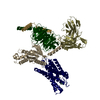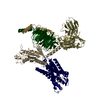+Search query
-Structure paper
| Title | Ligand recognition mechanism of the human relaxin family peptide receptor 4 (RXFP4). |
|---|---|
| Journal, issue, pages | Nat Commun, Vol. 14, Issue 1, Page 492, Year 2023 |
| Publish date | Jan 30, 2023 |
 Authors Authors | Yan Chen / Qingtong Zhou / Jiang Wang / Youwei Xu / Yun Wang / Jiahui Yan / Yibing Wang / Qi Zhu / Fenghui Zhao / Chenghao Li / Chuan-Wei Chen / Xiaoqing Cai / Ross A D Bathgate / Chun Shen / H Eric Xu / Dehua Yang / Hong Liu / Ming-Wei Wang /    |
| PubMed Abstract | Members of the insulin superfamily regulate pleiotropic biological processes through two types of target-specific but structurally conserved peptides, insulin/insulin-like growth factors and ...Members of the insulin superfamily regulate pleiotropic biological processes through two types of target-specific but structurally conserved peptides, insulin/insulin-like growth factors and relaxin/insulin-like peptides. The latter bind to the human relaxin family peptide receptors (RXFPs). Here, we report three cryo-electron microscopy structures of RXFP4-G protein complexes in the presence of the endogenous ligand insulin-like peptide 5 (INSL5) or one of the two small molecule agonists, compound 4 and DC591053. The B chain of INSL5 adopts a single α-helix that penetrates into the orthosteric pocket, while the A chain sits above the orthosteric pocket, revealing a peptide-binding mode previously unknown. Together with mutagenesis and functional analyses, the key determinants responsible for the peptidomimetic agonism and subtype selectivity were identified. Our findings not only provide insights into ligand recognition and subtype selectivity among class A G protein-coupled receptors, but also expand the knowledge of signaling mechanisms in the insulin superfamily. |
 External links External links |  Nat Commun / Nat Commun /  PubMed:36717591 / PubMed:36717591 /  PubMed Central PubMed Central |
| Methods | EM (single particle) |
| Resolution | 2.75 - 3.19 Å |
| Structure data | EMDB-33871, PDB-7yj4: EMDB-33888, PDB-7yk6: EMDB-33889, PDB-7yk7: |
| Chemicals |  ChemComp-IYF:  ChemComp-IYM: |
| Source |
|
 Keywords Keywords |  STRUCTURAL PROTEIN / human relaxin family peptide receptor 4 / STRUCTURAL PROTEIN / human relaxin family peptide receptor 4 /  G protein-coupled receptor / ligand recognition G protein-coupled receptor / ligand recognition |
 Movie
Movie Controller
Controller Structure viewers
Structure viewers About Yorodumi Papers
About Yorodumi Papers











